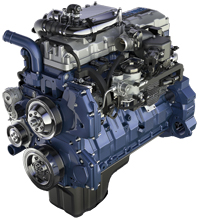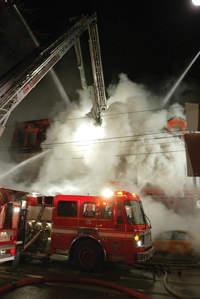
Equipment
Emissions issues
A new emissions standard for diesel engines that takes effect Jan. 1
means Canadian fire departments will pay thousands of dollars more for
apparatus starting next year.
The new standard will reduce the amount of nitrogen oxides (NOx)
emitted by diesel engines to 0.2 grams per brake horsepower hour from
the 2007 level of 1.2 g/hp-hr.
November 6, 2009
By James Careless
A new emissions standard for diesel engines that takes effect Jan. 1 means Canadian fire departments will pay thousands of dollars more for apparatus starting next year.
The new standard will reduce the amount of nitrogen oxides (NOx) emitted by diesel engines to 0.2 grams per brake horsepower hour from the 2007 level of 1.2 g/hp-hr.

|
|
| Photo by John Riddell
|
Meeting the standard has forced North American engine manufacturers to either substantially redesign their diesel engines and/or add extra exhaust filtering systems. Some companies have stopped making these engines altogether, saying the expense isn’t worth the return.
Re-engineering diesel truck engines is expensive. “It has been a tremendous effort for Navistar to redesign our engines,” says Bob Neitzell, vocational marketing manager for Warrenville, Ill.-based engine maker Navistar International. “We started back in 2006 by developing our MaxxForce line, which met 2007 EPA regulations and the 2010 EPA standards coming into force now.”
Unfortunately, the cost of meeting the standard is being passed on to chassis manufacturers and, from there, to fire departments. The amount of the price increase depends on whom you talk to.
“I don’t think anyone has got the firm price calculated yet because of the other changes and effects but I’ve heard anywhere from $10,000 to $15,000, which I think is a good guestimate,” says John Witt, who owns Smeal dealer Safetek Emergency Vehicles in Abbotsford, B.C.
“We are told by a U.S, manufacturer of custom chassis that the cost increase per engine will be anywhere from $17,000 to $25,000 each – in U.S. dollars,” adds Harvey Goodwin, marketing director for Abbotsford, B.C.-based manufacturer Hub Fire Engines.
■ The 2010 engines
Witt notes that the emission requirements have caused Detroit Diesel and Caterpillar to drop out of the emergency vehicle market. That leaves only engine-maker Cummins Inc., which uses SCR technology, and Warrenville, Ill.-based Navistar with EGR technology.
 |
|
| Meeting the new emissions standard has forced North American engine manufacturers to either redesign their diesel engines and/or add extra exhaust filtering systems.
|
EGR stands for Exhaust Gas Recirculation. In Navistar’s ERG system – marketed under the name MaxxForce – the exhaust is re-circulated back into the engine’s pistons along with the fuel. This results in NOx compounds being burned up rather than being emitted.
SCR stands for Selective Catalytic Reduction. Rather than re-circulating the exhaust gas back to the engine, the exhaust is passed through a spray of urea (a form of nitrogen) on its way out of the vehicle. The urea interacts with the NOx, converting it to harmless nitrogen and water. Standard particulate filtering is required but does not have to be increased for SCR-based engines.
SCR engines are simpler than EGR engines but they require the trucks to have an extra catalytic system added, plus a tank loaded with DEF (Diesel Exhaust Fluid, a.k.a. urea) that must be kept filled.
“When you factor in the extra tank, plus the piping and other equipment required for an SCR system, it can end up taking up 14 cubic feet or more on an average fire truck,” says Rick Suche, president of manufacturer Fort Garry Fire Trucks in Winnipeg.
“You also have to keep the DEF tank filled with enough liquid to work. Otherwise, the engine’s electronic monitoring system may prevent you from using the vehicle at full power.”
DEF fluid is estimated to cost nearly as much as diesel. As for consumption, according to Cummins’ website (www.everytime.cummins.com ), “DEF consumption is expected to be approximately two per cent of fuel consumption dependent on vehicle operation – duty cycle, geography, ratings, et cetera.”
Which kind of diesel should a department choose for its apparatus?
“In our opinion, one particular solution is no better than the other,” says Matt Creech, director of fire truck sales for Spartan Chassis in Charlotte, Mich.
“Both strategies have definite advantages but it is our customers that will choose which solution best meets their needs.”
■ Impact on fire apparatus
The Canadian On-Road Vehicle and Engine Emission Regulations include prescribed technical standards that establish maximum emissions limits for heavy- duty diesel engines such as those used in fire trucks. These technical standards correspond to those of the U.S. Environmental Protection Agency, which were incorporated from the U.S. Code of Federal Regulations (CFR) to ensure that the specified standards are identical in both countries.
According to Environment Canada, the Canadian standards are aligned with those of the EPA and vehicles/engines covered by an EPA certificate are deemed to satisfy the regulations for the applicable model year. Compliance is mandatory.
The On-Road Vehicle and Engine Emission Regulations are available for review on the CEPA environmental registry at www.ec.gc.ca/CEPARegistry/regulations/detailReg.cfm?intReg=65 .
 |
|
| Apparatus makers estimate a price increase of at least $8,000 for 2010. Photo by John Riddell |
“The most notable change will be the addition of Selective Catalytic Reduction on engines other than the Navistar MaxxForce,” says Harvey Dussault, general manager of Rosenbauer dealer Rocky Mountain Phoenix in Red Deer, Alta.
Besides the extra components, pipes and DEF tanks (Dussault says the tanks will probably be under 10 gallons) the trucks will be designed to provide higher heat rejection and an increase in cooling and air flow.
“This will result in some changes to the cab to allow for these components,” he says.
For an apparatus outfitter such as Spartan Chassis, “integrating emissions solutions into our products has been a tremendous challenge,” says Spartan’s Matt Creech.
“There will be an overall weight impact as a result of the emissions changes. Spartan’s Gladiator cab will increase slightly in width, which will, as a result, increase the weight of the cab.
“There will also be additional weight to the chassis that include the SCR system. A switchback exhaust configuration (urea canister SCR catalyst stacked on top of the diesel particulate filter or DPF) for SCR chassis with a short wheelbase and SCR) may impact the useable space in the body behind the cab on the officer’s side.”
“The new engines are going to add weight to the apparatus, which is already being affected by the requirements of the NFPA 1901-2009 standard as to additional features/requirements,” echoes Safetek’s Witt.
“There are also the exhaust location requirements that have already created high temperature discharge issues. The placement of the exhaust . . . will impact the larger GPM pump modules and in many cases the rescue body compartment depth and mounting for all apparatus.”
■ Impact on your department
Spartan’s Creech puts it bluntly: “There will be a price increase associated with the 2010 emission engines, as there are additional parts, components and complex systems required by the new technology.”
Dan Sutphen, sales manager with apparatus manufacturer Sutphen Fire Trucks in Dublin, Ohio, agrees. “We have spent more money on engineering these engines into our chassis, so there will be additional cost.”
Safetek’s John Witt puts it more boldly. “The 2010 EPA engine requirements not only affect Safetek but all of the fire service,” he says. “It’s going to increase the cost of apparatus to many of those fire departments already facing shrinking or limited budgets.
“We may see apparatus purchases delayed or refurbishment of existing apparatus to extend the service life a few more years until the issues with the new 2010 emission technology are proven; that is, i.e. SCR versus EGR. There is also the issue of the 2012 EPA standard, which is going to further affect our industry.”
The 2012 EPA emission standard will be even stricter than the 2010 standard.
So, what’s a cash-strapped fire department to do? There’s not much they can do, says Pino Natale, director of the emergency vehicle division of Dependable Truck and Tank Ltd. in Brampton, Ont. “You can buy 2009 trucks now if you have the budget,” he says. “But theat fact is that there are not that many 2009 engines still available.”
Sutphen agrees. “If at all possible, you should buy before the end of the year,” he says. “Costs will increase between $15K and& $20K after the first of 2010.”
“The only way around these additional costs for new fire apparatus isare to purchase before the end of the calendar year,” echoes Mike Moore, Pierce Manufacturing’s director of strategic product development and support.
“Pierce is estimating the additional costs for the 2010 engines to run from US$8,000 to US$23,000. This range is dependent on chassis (commercial or custom) and engine size.”
How are Canadian fire departments reacting to all this?
“There are a great number of my customers who’ve elected to order now to avoid the problems and costs associated with the 2010 EPA engines,” says Safetek’s Witt. “I have one major customer who’s ordered their 2010-2011 apparatus so that they can be fitted with 2009 engines at today’s prices. We are working closely with Spartan Chassis, who I use exclusively, in pre-ordering engines in advance of the 2010 requirements.”
However, over at Rocky Mountain Phoenix, “there do not seem to be customers lining up to make early purchases to beat the 2010 emission costs as they did during the last EPA changes,” says Harvey Dussault. “This is probably due to the recession, as politicians are holding the line on capital expenditures because of the optics to the taxpayers. They don’t want to appear to be spending money at this time. The last EPA change in 2007 saw a glut of business with departments taking advantage of saving the EPA increase, [but] this is not the case this time around.”
Print this page